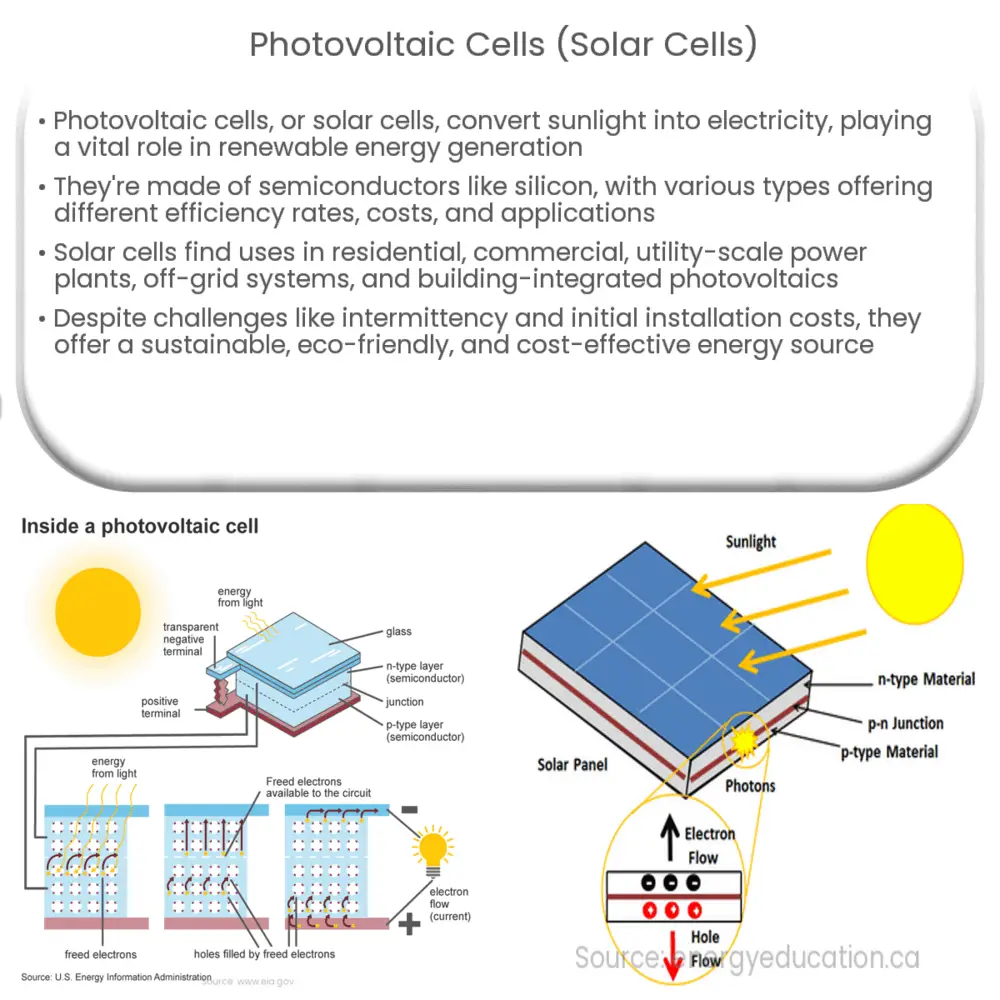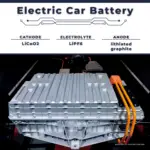Photovoltaic cells convert sunlight into electricity, offering a clean, renewable energy source for homes, businesses, and utility-scale power plants.

Photovoltaic Cells (Solar Cells): Harnessing the Power of the Sun
Introduction to Photovoltaic Cells
Photovoltaic cells, commonly known as solar cells, are devices that convert sunlight into electricity using the photovoltaic effect. This process occurs when light energy, or photons, strike the surface of a solar cell, knocking electrons loose from their atoms. The free electrons then flow through the cell, generating an electric current. Solar cells have become an essential part of the renewable energy landscape, providing a clean, sustainable, and inexhaustible source of power.
How Solar Cells Work
Solar cells are made from semiconductor materials, such as silicon, which have unique properties that allow them to generate electricity when exposed to sunlight. These materials have an atomic structure that creates a natural electric field at the junction between two layers with different electron concentrations. When photons hit the semiconductor, they dislodge electrons from their atoms, creating electron-hole pairs. The electric field at the junction pushes the electrons towards the front of the cell and the holes towards the back, generating a flow of electric current.
Types of Solar Cells
There are several types of solar cells available, each with its own advantages and disadvantages. Here are some of the most common types:
- Monocrystalline Silicon Solar Cells: These cells are made from a single crystal of silicon and are the most efficient type of solar cell available, with efficiency rates ranging from 20-25%. They also have a longer lifespan than other types, but they are more expensive to produce.
- Polycrystalline Silicon Solar Cells: These cells are made from multiple silicon crystals and have slightly lower efficiency rates (15-20%) compared to monocrystalline cells. However, they are less expensive to manufacture and are more widely used as a result.
- Thin-Film Solar Cells: This type of solar cell is made by depositing a thin layer of semiconductor material onto a substrate, such as glass or metal. Thin-film cells are less efficient than silicon cells, with efficiency rates between 10-12%, but they are more flexible and can be integrated into various surfaces, including building materials. They are also cheaper to produce.
- Multi-Junction Solar Cells: These cells consist of multiple layers of different semiconductor materials, each designed to absorb a specific range of wavelengths. This allows the cell to capture more of the solar spectrum, resulting in higher efficiency rates (30-40%). However, multi-junction cells are complex and expensive to produce, limiting their widespread use.
Applications of Solar Cells
Solar cells have a wide range of applications, from small-scale residential installations to large utility-scale power plants. Some common applications include:
- Residential Solar Systems: Homeowners can install solar panels on their rooftops or in their yards to generate electricity for their households. This reduces reliance on grid electricity, lowers energy bills, and decreases the environmental impact of energy consumption.
- Commercial Solar Systems: Businesses can use solar panels to power their operations, reducing operating costs and demonstrating a commitment to sustainability. Solar power can be particularly beneficial for businesses with high energy consumption, such as data centers or manufacturing facilities.
- Utility-Scale Solar Power Plants: Large solar farms can generate electricity on a massive scale, feeding it directly into the power grid. These plants can cover several square kilometers and produce enough electricity to power thousands of homes.
- Off-Grid Solar Systems: In remote areas with no access to the power grid, solar panels can provide a reliable source of electricity. This can be particularly valuable for powering telecommunication equipment, water pumps, or medical facilities in rural areas.
- Building-Integrated Photovoltaics (BIPV): Solar cells can be integrated directly into building materials, such as windows or facade panels, allowing structures to generate their own electricity. This can help achieve energy efficiency goals and reduce the overall carbon footprint of the building.
Advantages and Challenges of Solar Energy
Solar energy offers numerous benefits, but it also faces some challenges. Here are the main advantages and disadvantages of solar cells:
Advantages
- Renewable and Sustainable: Solar energy is an inexhaustible resource, making it a reliable long-term solution for our energy needs.
- Environmentally Friendly: Solar cells produce electricity without emitting greenhouse gases or other pollutants, helping to combat climate change and improve air quality.
- Low Operating Costs: Solar systems require minimal maintenance and have no fuel costs, making them a cost-effective source of energy over their lifetimes.
- Energy Independence: By generating their own electricity, households and businesses can reduce their dependence on grid electricity and protect themselves from fluctuating energy prices.
Challenges
- Intermittency: Solar energy production depends on sunlight, which can be affected by weather conditions and the time of day. This makes it necessary to develop energy storage solutions or complementary power sources to ensure a consistent supply of electricity.
- Installation Costs: The initial cost of installing solar panels can be high, although government incentives and the long-term savings on energy bills can help offset this expense.
- Land Use: Large-scale solar farms require significant land area, which can lead to concerns about land use and environmental impact. However, innovative solutions like floating solar panels or integrating solar cells into building materials can help mitigate this issue.
In conclusion, photovoltaic cells are a vital component of our transition to a sustainable energy future. By harnessing the power of the sun, we can reduce our reliance on fossil fuels, minimize greenhouse gas emissions, and secure a clean, reliable energy supply for generations to come.



